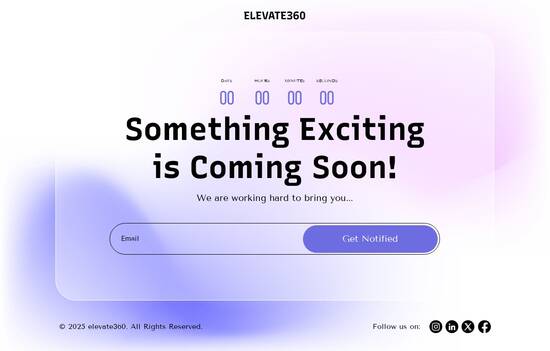
Static countdown timer page template
Explore Similar TemplatesAbout template
Unleash your creativity with the static countdown timer page template. Try Instapage today.
Recommended templates

Easy to build without coding
With the intuitive drag-and-drop builder, anyone on your team can create high-converting pages without any knowledge of code or design. Make enhancements to your landing page with custom widgets using Javascript, HTML/CSS, or third-party scripts.

Multiple layouts for any industry and goal
Select from 500+ landing page layouts built to boost conversions across industry-specific scenarios. Customize them by adjusting fonts, adding images, and generating on-brand content with the AI assistant. Quickly scale with Instablocks® and Global Blocks that you can save, reuse, and update globally.

Loads fast and looks polished on any device
Every template is responsive, which means they present professionally on any device and load blazingly fast with our Thor Render Engine. You can also power them up with Google AMP technology to deliver an unparalleled mobile experience and drive higher conversions.

Robust analytics & experimentation
Get real-time updates and reporting across all your devices, showing the number of visitors, conversions, cost-per-visitor, and cost-per-lead. Launch AI-powered experiments, run A/B tests, and use heatmaps to analyze user behavior, then optimize your landing page to maximize conversions.







Easy to build without coding
With the intuitive drag-and-drop builder, anyone on your team can create high-converting pages without any knowledge of code or design. Make enhancements to your landing page with custom widgets using Javascript, HTML/CSS, or third-party scripts.
Multiple layouts for any industry and goal
Select from 500+ landing page layouts built to boost conversions across industry-specific scenarios. Customize them by adjusting fonts, adding images, and generating on-brand content with the AI assistant. Quickly scale with Instablocks® and Global Blocks that you can save, reuse, and update globally.
Loads fast and looks polished on any device
Every template is responsive, which means they present professionally on any device and load blazingly fast with our Thor Render Engine.
Robust analytics & experimentation
Get real-time updates and reporting across all your devices, showing the number of visitors, conversions, cost-per-visitor, and cost-per-lead. Launch AI-powered experiments, run A/B tests, and use heatmaps to analyze user behavior, then optimize your landing page to maximize conversions.
All the features you need to build lead-generating landing pages
Explore more featuresLearn how to build top-performing landing pages for any goal
FAQs
Leading the way in building high-performing landing pages





An essential static countdown timer page template
In the realm of online marketing, a well-crafted static countdown timer page template serves as a potent tool to stimulate urgency and enhance conversions. Instapage's customizable templates enable marketers to integrate countdown timers seamlessly, allowing businesses to foster excitement around limited-time offers and significantly boost their campaign performance.
Why choose a static countdown timer page template?
Static countdown timers create a sense of urgency, which can motivate potential customers to act quickly. Here are a few reasons to consider:
- Increased urgency: Countdown timers visually remind visitors that time is running out, pushing them toward quicker decision-making.
- Improved conversions: Studies have shown that urgency-related elements can increase conversion rates effectively.
- Enhanced marketing strategy: Integrating countdowns into campaigns makes offers appear more appealing and exclusive.
Setting up your static countdown timer page template
Creating a countdown timer page involves several straightforward steps:
- Select a template: Begin with one of Instapage's 100+ customizable templates that cater specifically to countdown offers.
- Customize elements: Modify text, colors, and images to align the page with your campaign’s branding and messaging.
- Add the countdown timer: Use intuitive tools to embed countdown functionalities directly into your page, defining the end date and time for the offer.
Optimizing your countdown timer page for performance
Optimization ensures your countdown timer page will attract and convert visitors effectively. Key strategies include:
- A/B testing: Experiment with different layouts, messages, or timer styles to discover which configurations yield the highest conversion rates.
- Analytics tracking: Utilize Instapage’s built-in tools to monitor user behavior and make data-driven decisions for continuous improvement.
- Personalization: Adapt your countdown messages based on audience demographics for more targeted impressions.
By leveraging these strategies through Instapage, marketers can maximize their return on investment and ensure their countdown timer pages are both compelling and high-performing.
In conclusion, a static countdown timer page template is an invaluable asset for any digital marketing campaign intended to drive urgency and conversions.
Get started with Instapage today and transform your marketing strategy with our powerful landing page capabilities!
People also ask about Static countdown timer page template
Static countdown timer page template: An interactive tool for engagement
The significance of countdown timers in digital marketing
Countdown timers have long been recognized as powerful tools in digital marketing, setting an atmosphere of anticipation and urgency among users. Historically, countdown clocks originated from event launches and promotions in various industries. As online shopping and digital marketing transformed, the use of countdown timers became more prevalent, evolving from analog clips in advertisements to trendy digital widgets that enhance user experience.
The psychological impact of countdown timers is notable; they induce a sense of urgency and FOMO (fear of missing out) in potential customers. This phenomenon creates a mental trigger, prompting immediate action—such as making a purchase or signing up for a service—while the clock is ticking. Additionally, statistics bolster their utility: studies show that websites featuring countdowns experience higher conversion rates and increased engagement. Incorporating a well-designed countdown timer page can effectively enhance the overall marketing strategy.
Fundamentals of a static countdown timer page template
At its core, a static countdown timer is a visual representation of time remaining until a specific event or deadline. Unlike dynamic or live countdowns, a static countdown timer displays a fixed time displayed independently from server time, ensuring consistent experiences across different internet connections. This setup is beneficial for marketing campaigns that require users to understand precisely how much time remains without concern for variable load times.
Key components of a static countdown timer template play a vital role in user engagement. Display elements including clear, bold fonts and contrasting color schemes enable users to gauge the remaining time quickly. Meanwhile, functional elements might involve user inputs that enhance their interaction. For instance, users can sign up for alerts as the timer approaches zero, prompting them to take action immediately when their desired offer becomes available.
Unpacking the technical implementation
Building a static countdown timer page template requires understanding the core technologies. First, HTML provides the essential structure for your countdown timer. This foundation allows you to define various components such as the heading, timer display, and additional interactive fields for user engagement. Using semantic HTML promotes accessibility, ensuring that all users can easily navigate and understand the content.
Next, CSS is essential for styling, allowing you to create a visually appealing layout. With it, you can choose color schemes that align with your brand and use fonts that capture attention. JavaScript takes this a step further by adding necessary interactivity. By incorporating functions to manipulate the DOM, you can create dynamic countdown functionality, enabling real-time updates as the timer counts down.
HTML structure: Building the foundation to support visual elements.
CSS styling: Enhancing aesthetics and brand representation.
JavaScript capabilities: Bringing dynamic interaction to life.
Feature-rich functionality of countdown timers
One advantage of implementing static countdown timers is the ability to customize the display options according to branding needs and preferences. Key choices include choosing formats that show days, hours, minutes, and seconds depending on the urgency level associated with the event. Bright contrasting colors help in grabbing attention, while specific fonts may improve brand recognition and trustworthiness.
Furthermore, countdown behavior settings like predefined end dates or dynamic dates tailored for each customer can impact user experience significantly. Predefined timers create a sense of urgency for specific offerings, while dynamic timers apply to personalized user scenarios, like subscriptions or courses. Implementing user control mechanisms, such as options to pause, reset, or restart, provides further flexibility and enhances user engagement.
Versatility across industries: Use cases for static countdown timers
Static countdown timers find diverse applicability across industries, notably in e-commerce, event promotions, and product launches. For e-commerce platforms, countdowns can highlight flash sales or limited-time offers, prompting customers to act swiftly. The visual cue of time running out can fast-track the decision-making process, resulting in increased sales and higher turnover.
In the realm of event promotions, static timers are excellent tools for driving registrations to webinars and virtual events. As attendees become aware of time constraints, they're more likely to sign up. Product launches can also benefit considerably—creating anticipation through a static countdown page can greatly enhance prior engagement and drive traffic to launch events. These practical uses illustrate the broader applicability of countdown timers beyond simple displays.
Optimization strategies for maximal impact
For marketers deploying static countdown timers, optimization strategies enable maximal impact and enriched user experiences. One effective method is to undertake A/B testing, exploring variations in design and functionality to identify which elements resonate best with the target audience. Testing different color schemes, timer placements, or wording can yield insightful data to refine engagement tactics.
Additionally, tracking analytics remains crucial for measuring engagement and conversion rates. Utilizing built-in analytic tools can provide insights into how users interact with the countdown. Behavioral data allows for implementing necessary adjustments and real-time modifications resulting in improved performance.
Best practices for implementing a static countdown timer
Timing your countdown launch effectively is crucial. Understanding when your target audience is most likely to engage can enhance effectiveness. Research shows that late afternoon and early evening may yield better results as users tend to browse during these hours. Following this, it’s essential to adhere to user experience (UX) guidelines, ensuring mobile responsiveness is prioritized. With a significant number of users accessing websites via mobile devices, a responsive design is imperative for maintaining accessibility.
Placement on landing pages also influences visibility. Strategically positioning countdown timers above the fold ensures immediate visibility upon page load. Combining countdowns with integrated marketing tools like email campaigns and social media promotions can drive further engagement. Embedding countdown timers in promotional emails enhances outreach, while sharing links on social platforms can lead traffic to a dedicated timer page.
Future trends: The evolution of countdown timers in digital marketing
Looking ahead, the evolution of countdown timers is poised for exciting opportunities in digital marketing. Automation and personalization will play significant roles, leveraging user data to deliver tailored countdown experiences. Understanding customer preferences allows businesses to present countdown messages that resonate deeply and engage users effectively, increasing overall ad efficiency and conversion.
Furthermore, AI-driven analytics can provide deeper insights into user behavior, allowing businesses to tailor their marketing approaches accordingly. Moreover, the integration with augmented reality (AR) offers innovative ways to bridge the gap between digital and physical experiences, offering users a unique perspective on promotions and new releases. These advancements promise to reshape how countdown timers are utilized moving forward.
Real-world examples and case studies
Many brands have successfully harnessed static countdown timers to great effect, serving as excellent case studies for marketers. For instance, seasonal sales during the holiday season often employ countdown timers to build urgency. Companies like Amazon have integrated timers for lightning deals, driving significant conversions. Such instances showcase how countdown timers can contribute to increased sales and heightened customer interest.
However, learning from common mistakes can be equally illuminating. Overloading countdowns with excessive information or placing them in non-prominent areas can dilute their effectiveness. Analyzing these missteps can foster a better understanding of optimal deployment strategies, ensuring your countdown timer delivers maximum impact in alignment with business goals.
Tools and resources for designing static countdown timer templates
Several tools and resources are available for designing static countdown timer templates, catering to both novice and experienced developers. Popular web development frameworks, including Bootstrap and Foundation, offer pre-built components for swift implementation. These frameworks facilitate cleaner designs and responsive layouts, streamlining the development process.
For those seeking convenience, online platforms abound with intuitive tools for easy countdown timer implementation. With user-friendly options, businesses can create visually appealing countdowns without requiring extensive coding knowledge. Template marketplaces also provide various designs, empowering users to find templates that cater to specific branding needs, providing flexible solutions to enhance marketing campaigns.
Engaging with the community: Forums and discussions around best practices
Engaging in community discussions is not only enriching, but it also fosters collaboration and learning among marketers. Online communities, such as various forums and social media groups, enable professionals to share insights and learn from each other's experiences. It’s often in these exchanges where innovative practices and effective strategies emerge.
Contributing to discussions allows marketers to stay updated on the latest trends and best practices surrounding countdown timer implementations. These platforms not only facilitate a deeper understanding of successful strategies but also help refine personal approaches, leading to the creation of more effective and impactful marketing campaigns.
Ready to skyrocket conversions?
Supercharge your ad campaigns with high-performing landing pages
Get started














